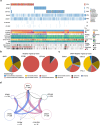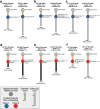This is a preprint.
Early Genetic Evolution of Driver Mutations in Uveal Melanoma
- PMID: 40585173
- PMCID: PMC12204427
- DOI: 10.1101/2025.06.10.25329358
Early Genetic Evolution of Driver Mutations in Uveal Melanoma
Abstract
Uveal melanoma (UM) is an aggressive cancer of the eye that frequently results in metastatic death. UMs are most likely to metastasize when they are small, at a time when they are difficult to distinguish from benign nevi and often observed without treatment. Unfortunately, little is known about the early genetic evolution of UM or potential biomarkers to indicate small tumors undergoing malignant transformation. Here, we performed targeted next generation sequencing for the 7 canonical UM driver mutations in 1140 primary UMs, including 131 small early-stage tumors. We found that the evolutionary burst of genetic aberrations that determines the archetypal UM subtypes and metastatic propensity has already occurred by the time most small tumors are biopsied, although a significantly larger proportion of small tumors are still evolving compared to larger tumors. We found that the 15-gene expression profile (15-GEP) support vector machine discriminant score was the best indicator of tumors in transition from low-risk Class 1 to high-risk Class 2 signature. While BAP1, SF3B1 and EIF1AX mutations were associated with poor, intermediate and good prognosis, respectively, mutation analysis was inferior to the prospectively validated 15-GEP + PRAME expression classifier for predicting metastasis-free and overall survival. These results provide a more complete picture of genetic evolution in UM, and they move us closer to a molecular definition of malignant transformation in this cancer type.
Keywords: Cancer mutations; Cancer prognosis; Choroidal melanoma; Molecular Prognostication; Prognostic biomarkers; Prospective studies; Survival analysis; Uveal melanoma.
Conflict of interest statement
COMPETING INTERESTS J.J.D, C.L.D., E.W., M.A.M., T.S.F., A.H.S., D.A.R., I.K., K.D.P., H.N., T.A.A., P.M., B.K.W., E.S., S.C.N.O., J.W., D.S.G., J.M., S.D.W., T.T., Z.M.C. and J.W.H. have acted as consultants for Castle Biosciences. K.R.C. is employed by Castle Biosciences. J.W.H. has received royalties for intellectual property related to prognostic testing in uveal melanoma that was licensed to Castle Biosciences. The remaining authors declare no competing interests. Castle Biosciences played no role in the conceptualization, design, data analysis, decision to publish, or preparation of the manuscript; they only contributed to data collection by depositing deidentified genetic data into an encrypted REDCap database without access to patient data.
Figures





References
Publication types
Associated data
Grants and funding
LinkOut - more resources
Full Text Sources
